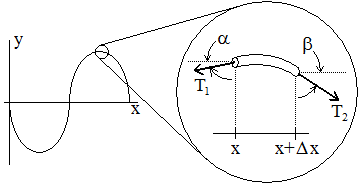Question
In: Physics
In terms of λ, f, μ, and T what times the square root of the tension...
In terms of λ, f, μ, and T what times the square root of the tension is equal to the wavelength?
Please show work, thanks.
Solutions
Expert Solution
The speed of propagation of a wave in a string ( ) is proportional to the square root of the
tension of the string (
) is proportional to the square root of the
tension of the string ( ) and inversely proportional to the square
root of the linear density (
) and inversely proportional to the square
root of the linear density ( ) of the string:
) of the string:

Derivation:

Let  be the length of a piece of string,
be the length of a piece of string,
 its mass, and
its mass, and  its linear density. If the horizontal
component of tension in the string is a constant,
its linear density. If the horizontal
component of tension in the string is a constant,  , then the tension acting on each side of the
string segment is given by
, then the tension acting on each side of the
string segment is given by


If both angles are small, then the tensions on either side are
equal and the net horizontal force is zero. From Newton's second
law for the vertical component, the mass of this piece times its
acceleration,  , will be equal to the net force on the
piece:
, will be equal to the net force on the
piece:

Dividing this expression by  and substituting the first and second
equations obtains
and substituting the first and second
equations obtains

The tangents of the angles at the ends of the string piece are equal to the slopes at the ends, with an additional minus sign due to the definition of beta. Using this fact and rearranging provides

In the limit that  approaches zero, the left hand side is the
definition of the second derivative of
approaches zero, the left hand side is the
definition of the second derivative of  :
:

This is the wave equation for  , and the coefficient of the second time
derivative term is equal to
, and the coefficient of the second time
derivative term is equal to  ; thus
; thus

where  is the speed of propagation of the wave in
the string. (See the article on the wave equation for more about
this). However, this derivation is only valid for vibrations of
small amplitude; for those of large amplitude,
is the speed of propagation of the wave in
the string. (See the article on the wave equation for more about
this). However, this derivation is only valid for vibrations of
small amplitude; for those of large amplitude,  is not a good approximation for the length
of the string piece, the horizontal component of tension is not
necessarily constant, and the horizontal tensions are not well
approximated by
is not a good approximation for the length
of the string piece, the horizontal component of tension is not
necessarily constant, and the horizontal tensions are not well
approximated by  .
.
Once the speed of propagation is known, the frequency of the
sound produced by the string can be calculated. The speed of
propagation of a wave is equal to the wavelength  divided by the period
divided by the period  , or multiplied by the frequency
, or multiplied by the frequency  :
:

If the length of the string is  , the fundamental harmonic is the one
produced by the vibration whose nodes are the two ends of the
string, so
, the fundamental harmonic is the one
produced by the vibration whose nodes are the two ends of the
string, so  is half of the wavelength of the fundamental
harmonic. Hence one obtains Mersenne's laws:
is half of the wavelength of the fundamental
harmonic. Hence one obtains Mersenne's laws:

where  is the tension (in Newton),
is the tension (in Newton),  is the linear density (that is, the mass per
unit length), and
is the linear density (that is, the mass per
unit length), and  is the length of the vibrating part of the
string.
is the length of the vibrating part of the
string.
lambda=(1/f) sqrt (T/mu)
This is the required derivation.
Related Solutions
Estimate the area A between the graph of the function f(x)= square root of x and...
What is the concept of the square root of time rule?
What is the root-sum-square uncertainty model?
Let X ~ exp(λ) MGF of X = λ/(1-t) a) What is MGF of Y =...
Use f(x) = ?2x, g(x) = square root of x and h(x) = |x| to find...
Let T∈ L(V), and let p ∈ P(F) be a polynomial. Show that if p(λ) is...
Differentiate the following: 1) f(x) = √2x-4. (all under square root) 2) f(x) = x/5-x 3)...
Let X and Y have joint PDF f(x) = c(e^-(x/λ + y/μ)) 0 < x <...
3.Both F and Chi Square distributions can be used to compare multiple sample means T/F 4.For...
T or F: The stock market far exceeds the bond market in terms of size of...
- If the density of the universe great than a critical value, then it might continue expanding...
- A 16.4-kg block rests on a horizontal table and is attached to one end of a...
- Freud’s theory of defense mechanisms has had a profound impact on the methods used by therapist,...
- discuss what a disclaimer is, when is it is issued, and how it would affect the...
- Explain why 1 additional net ATP is produced when the beginning substrate is glycogen compared to...
- What is Sales Tax, its salient features and how it works, do a comparative analysis between...
- E8-10 (Algo) Computing Depreciation under Alternative Methods LO8-3 Strong Metals Inc. purchased a new stamping machine...
 genius_generous answered 2 years ago
genius_generous answered 2 years ago